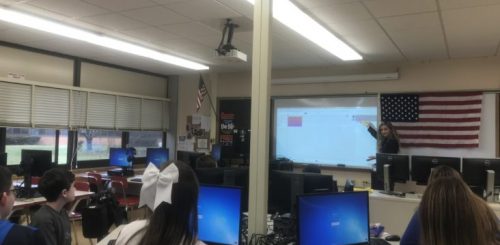
Soundtrap Engages Students on a New Level
February 6, 2017Soundtrap allows students to mix music and get valuable feedback, writes one teacher who uses it.
Soundtrap knows that a good education starts with a great teacher. That’s why we created Soundtrap to engage students on a new level.
As educators, we’re typically tasked with what can often seem a difficult-to-achieve goal – finding successful new methods for engaging every student even when our resources and budgets are limited.
And when it comes to the electronic devices that are now such a big part of our curriculum, another challenge is that the ideal software tools we select should run on all the incompatible platforms – Mac, Windows, Chromebook, iOS and Android – found in our school districts in order to reach every student.
I teach technology to students in 6th-12th grade in one of Canada’s poorest provinces, and I am always on the hunt for tools that will support these objectives. A couple of years ago, I was told to develop curriculum that would teach students how to produce different types of media. Unfortunately, our budgets are very small, our computers not the latest and the sound equipment we’d need for doing media work is extremely limited. Surely not unique issues for many teachers in today’s world!
A Solution Addressing Two Interests
Having done a little mixing and remixing of songs over the internet for fun, I’ve used Apple’s GarageBand recording studio with my students. I was attending an educators workshop last year, reviewing new software tools, when I learned about a new kind of online recording studio called Soundtrap. This lets kids make music with fellow students within an invited and secured group, record a tune or podcast, then share the music through the web, on the cloud, from a multitude of devices and operating systems.
It seemed to me that Soundtrap was an updated, improved concept compared to GarageBand. It was much easier to use, and would not only help me address my teaching requirements, but also involve an area – music – I love, so I was ready to pay for it out of my own pocket if administrators couldn’t find the money. Fortunately, it was priced low enough that this wasn’t necessary, so I tried it out with one class of older students.
We made a collaborative class album, and every student took part, each one making a track. Everyone – from a neurosurgeon’s kid sitting in my room to kids who weren’t interested in music at all – loved it. You could see these kids lighting up.
They liked the immediate feedback and the fact that they could comment on each other’s songs, and people could comment on their songs. Then the younger siblings of these students started to hear about it, and I soon expanded it to a second class, then to all my classes – nine in all, with about 24 children per class.
Cloud-based Software Increases Learning
Frequently, the electronic tools we use are limited to the classroom. When I was trying out this online recording tool, the kids would be getting into their song project, but then the bell would ring and you’d hear the sighs – they wanted to keep on working, which is just what we teachers strive for.
Fortunately, with cloud-based software like Soundtrap, students can keep working at home when they’re so engaged in a project. And they’d brag about their work and show it off at home, which made the younger kids want to try it.
I’m happy to see more cloud-based software, because it really does rip down the walls of a school. It makes learning happen any time during the day. And when students are so immersed in something, they see other ways of applying these skills. Our success producing the collaborative album wasn’t the end of it.
Some of my students developed iOS applications for kids who didn’t know the Swift language and Xcode development tools, and it became clear that Soundtrap was the best way to record the audio for our app, particularly since the results still sound good even when a school has old, inefficient microphones and other sound equipment.
Applying Tools to New Areas
Now, I’m thinking of adding podcasting to my lesson plans using Soundtrap. Even though this isn’t my passion, like music, I believe creating podcasts has great merit from an educational standpoint, and we haven’t done any yet.
It’s been gratifying to see my students begin thinking of ways to apply this tool to classroom activities, which demonstrates their engagement. For example, one student told me that it would be a great idea to make a radio commercial using Soundtrap as part of her social studies class when they focus on elections and government. Some of my students have said that this recording studio would make their music class more meaningful. Rather than spending hours learning an instrument, for example, with the only audience being those in the classroom, Soundtrap would let them put their music out to the world and get valuable feedback.
I believe that the recent availability of cloud-based, multi-platform tools like this one benefits education, where big companies like Apple have dominated for so long. Take GarageBand, which my students complain about, saying it hasn’t been improved in years. Kids want to keep up with the latest technology and learn new skills in the process, so having some viable competition in the space is a good thing, giving schools new options.
I just signed on for five years of Soundtrap because of how well it fits my overall goal of keeping lessons fresh, meaningful and engrossing while promoting collaborative learning. I’m looking forward to seeing other cloud-based software resources appear that will support my classes. While it’s good to successfully meet and exceed my requirements as a teacher, on a personal level, it’s been inspiring to see the impact on my students. All you’ve got to do is give these kids a useful tool like this, then sit back and watch the amazing things they can produce.
 EDU Portal
EDU Portal


